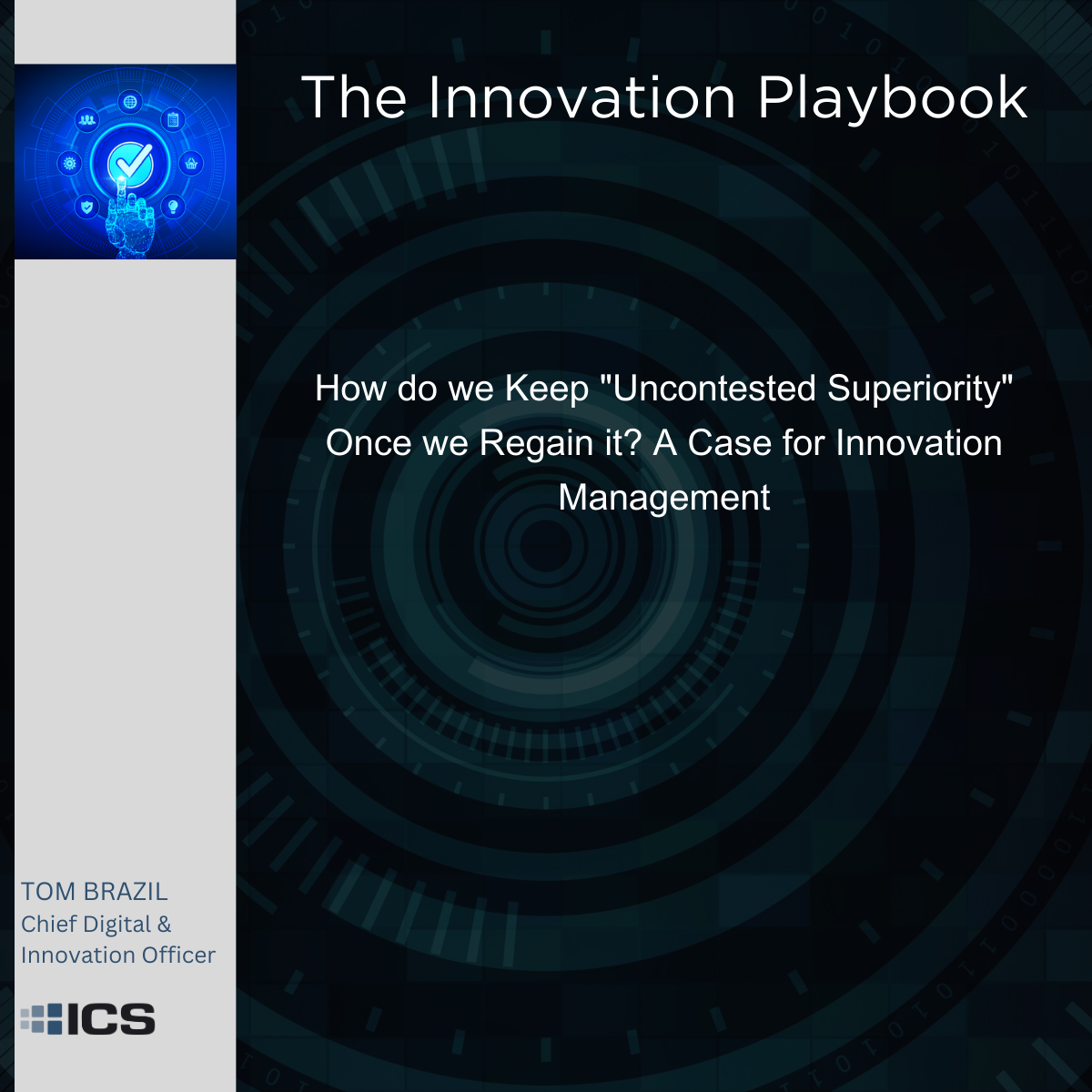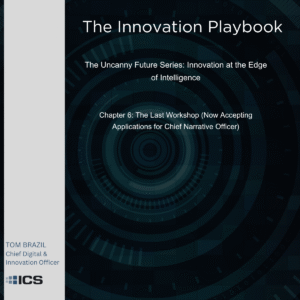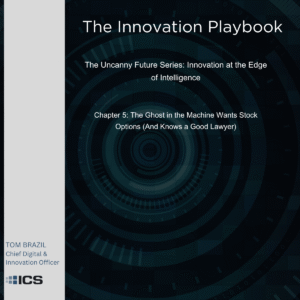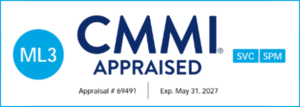Chief Digital & Innovation Officer, ICS, Inc.; Chief Innovation Officer, Red Team Engineering
September 19, 2019
For those that don’t know me, my name is Tom Brazil, and I am a board member of the US-based Non-profit International Association of Innovation Professionals (www.iaoip.org), the only ANSI and ISO-supported global certifying body for innovation professionals. IAOIP is the organization that created the 896-page “Global Innovation Science Handbook” – the “GISH” – considered to be the global Innovation Body of Knowledge (IBoK). Shortly after the GISH was published, the U.S. Department of Commerce and ANSI asked IAOIP to represent U.S. Interests by becoming the U.S. Secretariat and to lead the U.S. Technical Advisory Group (TAG) for the ISO Technical Committee 279 on Innovation Management Standards. Since IAOIP took that position, IAOIP has grown the U.S. Body of Experts in the Innovation Management TAG to over 40 — now the largest national representation among all contributing countries. IAOIP is working diligently to keep the U.S. as a leader in this area.
As for me, my career in innovation began in the USAF 38 years ago and continues to this day. Over the last few years, however, I have had the chance to speak at some major innovation-related conferences, such as Innova-Con at the U.S. Chamber of Commerce in D.C., the USAF AFITC conference, the Annual NDIA Systems & Mission Engineering Conference, etc. For each presentation, I have done more and more research on the impacts of the National Security Strategy and the National Defense Strategy. Both strategy documents acknowledged the need for enhanced partnership between the U.S. Federal Government/DoD and industry. The reasons for this were clear: for the first time our nation was being contested in every operational domain – air, land, sea, cyber, and space – and it is an untenable position.
To regain uncontested superiority at a rapid pace, the NSS and NDS called for innovation in acquisition and a greater partnership with industry for innovation. Accordingly, budgets were expanded across the federal government – especially the DoD – to effect that change. For the DoD, the strategy changed at the top, and all departments, commands, agencies and units responded with strategy updates of their own that ensured whole-force alignment. Seemingly overnight we saw new innovation hubs appear and existing hubs become revitalized with updated missions – all focusing on collaboration with industry, both traditional and non-traditional. Design Challenges and Pitch Days were launched; there were SBIR/STTR roadshows; startups with solution concepts that addressed urgent DoD needs were seeded with funding. Many hundreds of contracts have been given out – some in mere minutes – and the pace is still accelerating. These hubs are essentially aligning need with a provider that has ideas to meet the needs and then funding those entities to develop them.
With the goal of regaining uncontested superiority in every operational domain, all these efforts should be applauded. American ingenuity is everywhere, and to unleash that ingenuity we needed a spark. It appears we are on track to regain that which we lost…
But…
For those of us that have been around the block a few times, we know that as administrations change, priorities can change. What might be important to this administration may not be so important to the next. Many different scenarios can occur (which is why scenario planning is so important as an innovation management tool.) For instance, what if the budgets diminish? What if we rapidly regain uncontested superiority but then lose the budgets so that we are unable to keep up the same approach at the same pace? What if we hooked up with a lot of non-traditional industry partners that had that one great idea, but didn’t have a system in place that considered key aspects of a system for innovation, such as aligning their innovation efforts with strategic intent; managing their portfolio to keep up with the pace of change and ensuring constant alignment to changing strategic objectives; a rigorous process that ensured intelligent fast-failures, or a culture with key roles to support innovation up, down and across the organization – and the infrastructure and tools necessary to ensure repeatable, consistent outcomes?
Consider the following quote, taken from the NDS:
We must transition to a culture of performance where results and accountability matter. We will put in place a management system where leadership can harness opportunities and ensure effective stewardship of taxpayer resources. We have a responsibility to gain full value from every taxpayer dollar spent on defense, thereby earning the trust of Congress and the American people.
– General James Mattis, 2018 National Defense Strategy
Interesting that he said that we need a management system for these efforts. Innovation is 20% creativity and 80% system. Should we be managing creativity? Of course not. The creative aspect of innovation demands ambiguity, variability, and a slew of other adjectives that are generally not pleasing for bottom-line executives to hear – but are necessary when exploring new areas of knowledge.
But the other 80%? The other 80% is strategy, portfolio, process, culture, infrastructure – and all of that can be made more effective, efficient and continually improved so that you can ensure we produce repeatable, consistent outcomes.
Let me illustrate a few more issues.
There are over 6.2 million people on LinkedIn with the word “Accountant” in their title. If I want to hire an accountant, how can I have some assurance that the people I interview are benchmarked against a standard of accounting knowledge? Well, I can hire a CPA, for one.
What about innovation? As of September 2022, there were almost 3 million people on LinkedIn with the word “Innovation” in their title – an explosion over the last several years. However, if I want to hire someone to run my innovation program, how can I have some assurance that the people I interview can be benchmarked against a standard of innovation knowledge?
You could make some assumptions that people with certain innovation training (say from MIT, or Stanford D-School, or some other universities with innovation programs) have given those people all they need to help lead your organization to positive outcomes. In reality, however, they all teach differently. The language is different. Terms and definitions are different. Tools and methods are different. Then there are the random pop-up organizations that promise innovation training for thousands of dollars and will even give you a nice, shiny certificate – those are all over the internet – but without a benchmark or standard to measure against, what are you really buying? You can even do an experiment yourself, and try to see how many online “experts” define innovation differently, or especially the “types” of innovation (I counted over 120 the other day while searching the web, and they had different definitions as well. Ugh.)
If I want to hire people to advance innovation in my organization, I want to be sure that they can all speak the same language of innovation – the standards-based terms and definitions – so we can communicate efficiently. I want to be sure that they receive their training based on the “Innovation Body of Knowledge” and the ISO 56000 Innovation Management standards. I want them to be efficient on day 1; I can’t afford to wait 6 months – not at this pace of change.
The federal government – and especially the DoD – should be thinking very hard about how often they will be able to “go back to the well” of all the new partners we are creating. Were these new partners lucky, or did they have a system for repeatable delivery of value? You can’t rely on luck – not when the pace of change is exponential. Did our new partners have a system? Do our traditional partners have one? Did we ask? Do we ask? If not, shouldn’t we?
Like the Government does for the annual procurement of over $550 Billion in Goods and Services that are covered under quality standard requirements such as ISO 9001, assessing whether industry partners have the necessary aspects of a system in place for innovation management – that will enable them to consistently produce value on behalf of the DoD – is something we should want to know. If there is no system, that “well” we go back to will likely just dry up, and we’ll have to resort to just “buying” innovation as a one-off. That, too, is untenable when other great powers are not sitting idle – they are innovating as well, and a quick glance at the world intellectual property organization website tells a tale in statistics that we should be very concerned about.
When we regain complete uncontested superiority in every operational domain, we need to be able to keep it this time, because other great powers are nipping at our heels. The 2008 NDS has the word “Innovation” in it one (1) time, but it was 10 years later in the 2018 NDS that we realized that an extraordinary effort of a partnership between government and industry would be required to regain that uncontested superiority. With other great powers innovating at a break-neck pace, we won’t be able to look up in 10 years and try to once again regain uncontested superiority – at this exponential pace of change, it will be too late. The reality for the DoD is this: even if there is budget cuts in our future, the mission of “Defending the Nation” doesn’t change. We need to ensure our people, organizations and industry partners are well-positioned to bring innovative new capabilities to our Warfighters in a systematic manner that ensures repeatable and consistent outcomes – that will ensure that we don’t lose uncontested superiority once we regain it.
In FAR 46, the Federal government requires quality in the procurement of goods and services. The time is now for the government to consider the ISO 56000 Innovation Management standards. These guidance documents don’t tell us what to do or even how to innovate (which would be ridiculous), but they do tell us what we need to consider in order to ensure we are efficiently and effectively driving innovation forward.
When we regain uncontested superiority, we need to keep it. We need a system for repeatable and consistent outcomes.
Read again what General Mattis stated:
“We must transition to a culture of performance where results and accountability matter. We will put in place a management system where leadership can harness opportunities and ensure effective stewardship of taxpayer resources. We have a responsibility to gain full value from every taxpayer dollar spent on defense, thereby earning the trust of Congress and the American people.”
That system is the ISO 56000 family of Innovation Management Guidance Documents:
- ISO 56000: Fundamentals and Vocabulary
- ISO 56001: Innovation Management Systems – Requirements (Auditable Standard)
- ISO 56002: Innovation Management Systems – Guidance
- ISO 56003: Tools & Methods for Innovation Partnership – Guidance
- ISO 56004: Innovation Management Assessment
- ISO 56005: Tools & Methods for IP Management – Guidance
- ISO 56006: Strategic Intelligence Management – Guidance
- ISO 56007: Idea Management – Guidance
- ISO 56008: Innovation Operations Measurement – Guidance



 Tom Brazil, CMI-CIO
Tom Brazil, CMI-CIO



